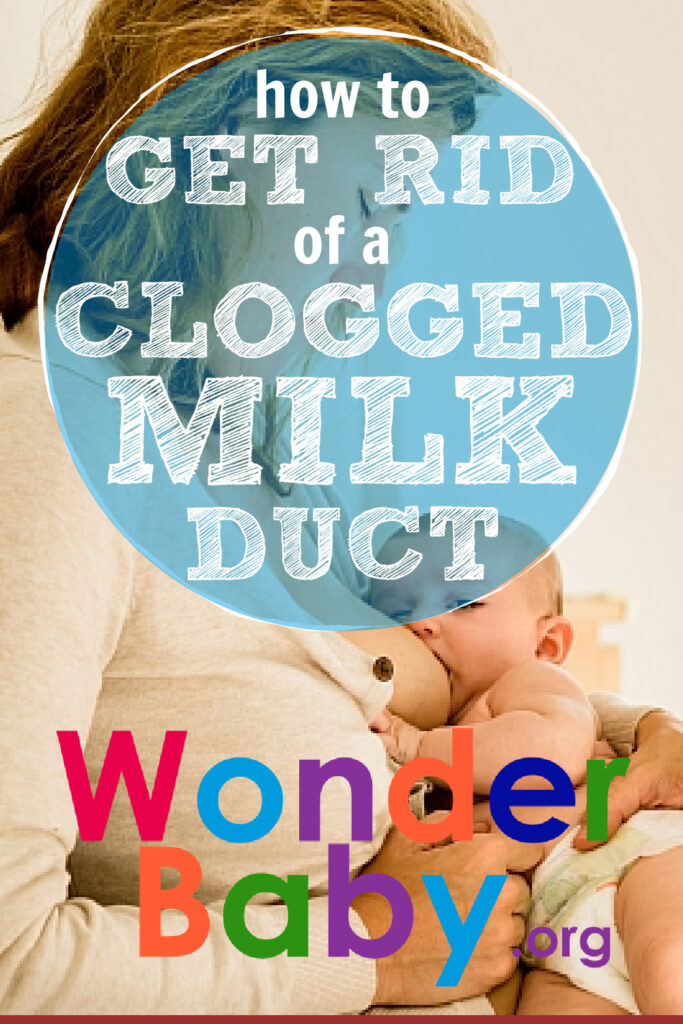How to Get Rid of a Clogged Milk Duct

- A plugged milk duct can be uncomfortable and interfere with breastfeeding.
- A red, hot, and painful breast lump may indicate a clogged duct.
- Mastitis is a serious breast infection resulting from clogged milk ducts.
- If Mastitis is left untreated, a breastfeeding mom can become quite ill.
- Contact your healthcare provider if you suspect you have a blocked duct or Mastitis.
Breastfeeding moms know the joy of snuggling close with their precious baby while nursing. These unforgettable and special moments are blissful snapshots of our cherished mothering experience.
I still remember the quiet moments with each of my infant daughters as they lay close to my breast, feeding contentedly. During these intimate times between me and my baby, I felt an inner calm and satisfaction that melded into overwhelming love for my child.
I will forever treasure our bonding time while breastfeeding.
However, nursing your baby can come with painful challenges such as cracked and dry nipples and plugged milk ducts. In addition to the discomfort and annoyance resulting from a clogged duct, you are at risk for a more serious condition called mastitis (more on this below).
Don’t panic. There are ways to prevent clogged milk ducts as well as methods to treat and eliminate this annoying condition. We will help you recognize the signs of a plugged duct and provide tips on managing breast pain and problems associated with the affected breast.
What Are Clogged Milk Ducts?
The American Academy of Pediatrics (AAP) recommends breastfeeding exclusively as the primary source of nutrition for infants six months and younger.
A study from the National Library of Medicine indicates that, unfortunately, 60% of breastfeeding moms do not continue to nurse their young as long as they intended due to emotional, social, and physical complications.
One of the hindrances to nursing can be in the form of clogged milk ducts. Partially or entirely blocked milk ducts occur due to plugged ducts in the breast—this obstruction results in poor milk flow, which can be painful for the mother and interfere with breastfeeding.
Clogged milk ducts occur in approximately 20% of nursing mothers and, fortunately, are typically easy to resolve. This issue can even settle on its own if you regularly breastfeed.
However, most of the time, you must take time and effort to get your milk flowing again.
There are simple measures to take to resolve a blocked milk duct. Once you know what to look for and the steps to take, your clogged ducts should run smoothly.
Even better, knowing how to prevent an obstruction in your breasts can help to sidestep the problem altogether!

What Causes Clogged Milk Ducts?
Certain circumstances while breastfeeding can cause the breast to empty inadequately. In the instance of a nursing mom, if the breast is restricted in some way or not drained completely, these conditions can cause a clogged milk duct.
Some reasons for a clogged milk duct can be:
- Your baby is having trouble latching onto your nipple and is latching and unlatching repeatedly.
- You frequently skip feedings or pumping sessions.
- Nursing only on one breast or infrequently alternating breasts.
- Wearing constricting tops or a tight bra can interfere with milk flow.
- Friction on your breasts from other sources such as a seatbelt, purse, or diaper bag strap.
- Conditions that separate you from your baby, such as your child being in the NICU.
- Not fully emptying the breast while feeding. Some reasons include time constraints or feeding multiples.
- Your baby is lip or tongue-tied.
For tongue-tied babies, measures to relieve clogged milk ducts may not be successful as further medical intervention is needed. According to the American Academy of Pediatrics, it is necessary to consult your healthcare provider for direction to avoid untimely weaning due to this condition.
A lactation consultant may also provide essential tips for management in this particular instance.
Factors that can increase the likelihood of developing a plugged duct are:
- Previous issues with plugged ducts or mastitis infections
- Mother is a smoker
- Weakened immune system
- Stress and fatigue
In addition, mothers with forceful letdown and milk oversupply are more likely to develop clogged ducts since baby can not accommodate so much milk. Due to this oversupply, breasts typically are not emptied fully during feedings causing ducts to become blocked.
How Long Do Clogged Milk Ducts Usually Last?
If you suspect that you have a blockage in your breast, it is best to try relief measures right away to get rid of it. Luckily, a clogged duct typically resolves within 24-48 hours once you take steps to help the problem.
Ignoring a plugged milk duct will only lead to more breast discomfort and possibly a breast infection (Mastitis).
How to Tell That You Have a Clogged Duct
Breastfeeding moms normally do not have difficulty recognizing that there is a problem when clogged ducts happen. A tell-tale sign is a painful breast lump and breast discomfort.
Knowing the indications of a plugged duct will help you to ease the issue quickly and hopefully without complication.
Symptoms of plugged milk ducts are:
- A small, painful lump on the breast
- Red, hot area on the breast near the lump
- The whole breast is tender
- Usually only affects one breast
- The flow of milk on the affected breast slows
- You notice a milk bleb (blister) on your nipple. Milk blebs are caused by clogged ducts near the nipple or nipple pore
Once you suspect that you have a clogged duct, don’t hesitate to take action.

Complications of a Clogged Milk Duct
Plugged milk ducts can cause more than breast pain for the mom. Any temporary decrease in milk flow or nursing routine can lead to breast refusal, early weaning, and infant weight loss.
A serious breast infection called Mastitis is the most dreaded complication of a clogged milk duct.
What is Mastitis?
Mastitis is a blocked duct that has not resolved, causing inflammation of the breast tissue and subsequent infection of the area.
You can not treat Mastitis on your own and should seek advice from your healthcare provider immediately if you suspect that you have this complication.
How Do I Know If I Have Mastitis?
You will know that you have something seriously wrong with your breast if you develop Mastitis. The red, painful area on your breast can look alarming, and you will develop body aches and flu-like symptoms.
Warning signs of Mastitis are:
- Swelling of the breast
- Red, hot, painful area of breast
- Hard, tender lump in the breast
- Fever over 101 F
- Feel run down and achy
- Mother feels nauseous
How is Mastitis Treated?
You will need to see your healthcare provider for medical treatment of Mastitis. Antibiotics and pain-relievers are necessary to clear the infection and deal with discomfort.
Measures to treat blocked milk ducts should also be instituted.
Just as important as physical complications of a clogged duct and Mastitis, disrupting the mother-child breastfeeding bond may lead to maternal depression and infant frustration.

How to Treat Clogged Milk Ducts and Prevent Mastitis
Knowing how to treat plugged milk ducts and applying specific measures right away is the best way to prevent Mastitis from occurring.
There are many time-tested and peer reviewed studies on treating a clogged breast, along with numerous home remedies that nursing moms swear by.
Conventional measures for the treatment of clogged ducts are:
- Regularly breastfeed on both breasts. Although it may be painful, it is important to continue breastfeeding on the affected breast.
- Nurse or pump frequently – experts recommend every 2 hours.
- Empty breast completely at each nursing session or when pumping.
- Apply a warm compress or a heating pad to the affected breast.
- Take a hot shower and aim the warm shower stream directly to the affected area or soak in a warm bath (every mom can use a relaxing bath so take advantage of this tip!).
- Gently massage the area before and during feeding.
- Stop wearing tight bras or other breast-constricting items.
- Prevent cracked nipples where infection can enter. Apply castor oil or a soothing nipple cream regularly after feeding or bathing.
- Drink lots of water.
- Consult your doctor and lactation consultant with any questions or concerns.
- Discuss physical therapy interventions to clear a clogged milk duct with your provider.
Other measures to clear a clog can be:
- Sunflower lecithin tablets (found in supplement store). There are also other types of lecithin supplements that may be helpful.
- Add Epsom salts to the bath or apply on wet warm compresses to soothe the affected breast.
- White vinegar compress for the nipple. Add a few drops of white vinegar to a cotton ball and apply to milk blebs on a nipple.
- A few drops of castor oil can be diluted with warm water and applied to a cloth to make a warm compress. Apply to tender lump and cover breast in plastic wrap, leaving your nipple out. Add a heating pad on low for 20 minutes before nursing. Monitor temperature to avoid burning your skin. Gently massage the area with your fingertips.
- Use a massager. Breast massagers are available to help with plugged milk ducts. Using an electric toothbrush is the same idea and may be easily accessible in your bathroom when needed.
- Try the dangle feeding position. This simple (but possibly tiring) position helps to clear the clog by using gravity to push out a clog. Simply feed your baby flat on their back with mom on all fours over baby (breast dangling over baby’s mouth).
Lactation consultants are experts in helping nursing moms to learn which breastfeeding positions will work best in every situation. This specialty nurse has many techniques to aid moms in their breastfeeding journey, clogged ducts included.
Don’t hesitate to ask for assistance or even to just vent frustrations. Every mother needs support, and your provider and nurses trained in breastfeeding are more than happy to assist you.
One Last Word
A clogged milk duct can happen to any breastfeeding mom. Although applying measures to prevent this issue is helpful, some moms still face the challenge of a blocked duct.
By knowing the signs and treatment of a plugged breast, most moms can rest assured that the problem will resolve quickly and without complication. Here’s to a happy feeding experience, moms!

The information WonderBaby provides is not intended to be, and does not constitute, medical or other health advice or diagnosis and should not be used as such. Always consult with a qualified medical professional about your specific circumstances.
Related Posts

Breastfeeding, Sleep
Sleep and Breastfeeding: A Comprehensive Guide for Nursing Moms
Many people assume breastfeeding and sleep training don’t go together, but it is possible to help your baby sleep better while continuing your breastfeeding journey.

Breastfeeding
Comfort Nursing: Pros, Cons, and How to Stop
Find out what comfort nursing is, when should you worry about it, and how to stop or limit your baby's comfort nursing (especially at night!).

Breastfeeding, Product Reviews
5 Best Breastfeeding Chairs for Nursing Moms of 2023
Whether you want a gentle rock, a smooth glide, or a cozy cuddle to soothe your baby to sleep, you’ll have your pick of the best breastfeeding chairs on the...